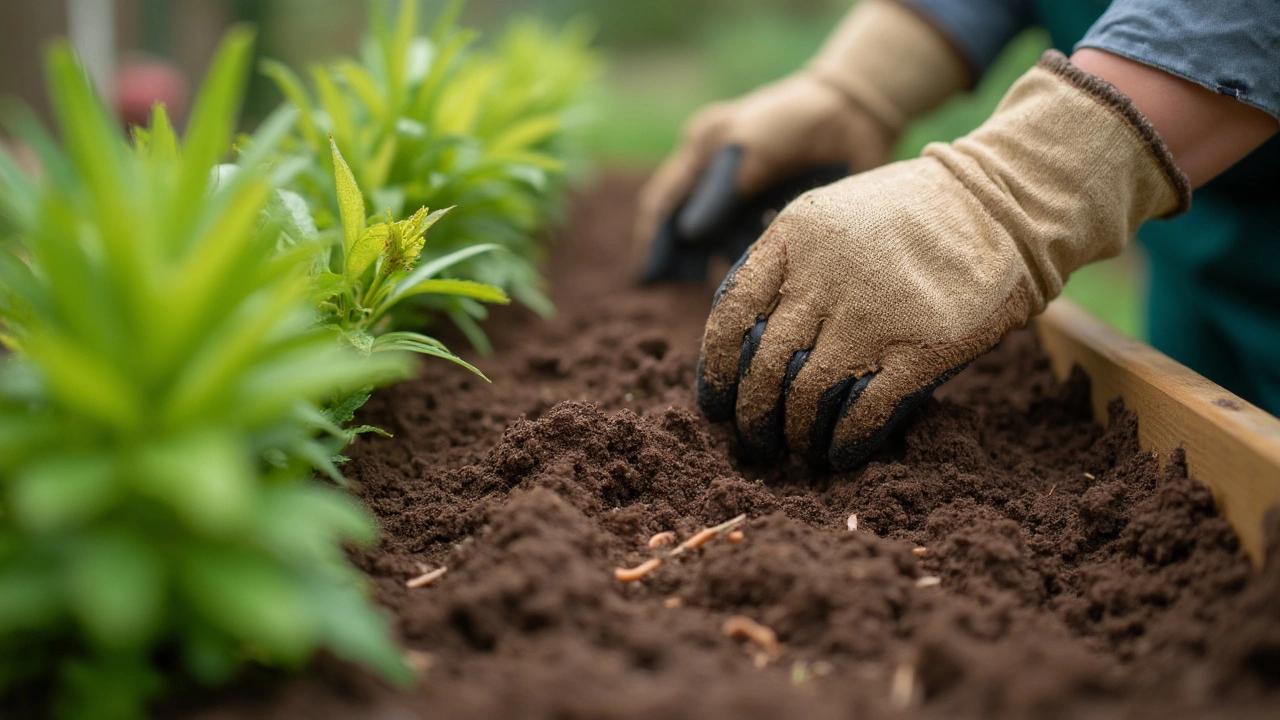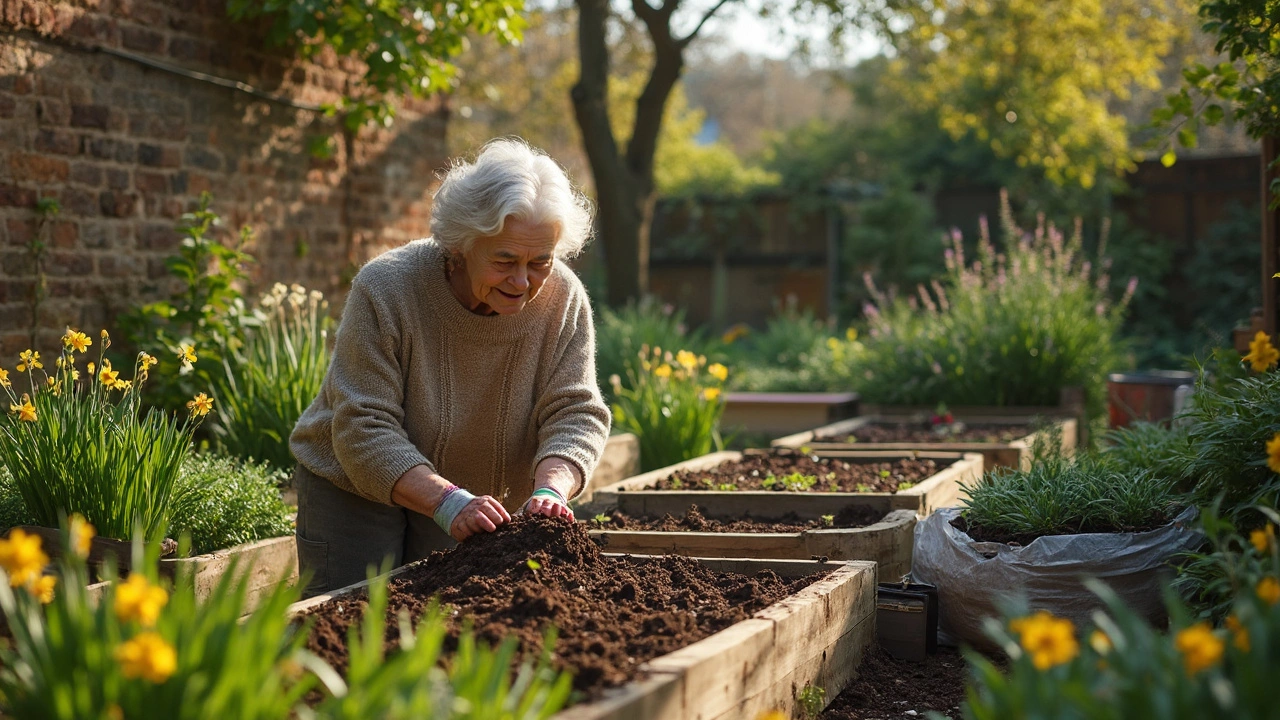Ever look at your raised garden bed and wonder if you really need to dump out all that dirt and start fresh? It feels like a massive job—and trust me, after wrangling bags of soil with my kids Marlon and Esme, I know it's a recipe for sore backs and grumpy moods. But hey, soil isn't like milk. It doesn't go bad overnight. The real question is, how do you know if your soil is still working for your plants?
Most raised beds don’t need a complete soil swap every season. In fact, regularly replacing all the soil is usually overkill—and expensive. Plants just care about what’s in the soil: nutrients, texture, and how alive it really is. Keeping your soil happy is more about topping it up and adding the right stuff, not starting from scratch each spring.
If you’re growing heavy feeders like tomatoes or squash every year, your soil might get a bit tired—sort of like you after a weekend of yard work. But more often, your bed just needs a little boost. There are a few easy ways to figure out what your soil needs (no fancy tests required). And you can bring it back to life without digging it all out.
- When Should You Replace Raised Bed Soil?
- How to Refresh Old Soil Without Removing It
- Spotting Signs of Tired or Unhealthy Soil
- Tips for Keeping Soil Healthy Year After Year
When Should You Replace Raised Bed Soil?
Most gardeners really don’t need to haul out all the soil from their raised beds every year. Actually, complete replacement is only needed in a few situations. Let’s look at the times you should consider it, and some facts to help you decide.
You definitely want to swap out all the soil if you’ve dealt with serious disease, toxic contamination (think spilled chemicals or lead paint), or massive pest problems that keep coming back no matter what you try. For regular wear-and-tear, it’s usually enough to fix up what you’ve got instead of going full reset mode.
- Raised bed soil should be replaced if you see extreme compaction—when it’s so hard roots can’t poke through it, even after loosening it up.
- Soil that smells sour, rotten, or like ammonia after rain may not bounce back and could be ready for the bin.
- If weeds or crops refuse to grow, despite good sunshine and watering, something might be way off balance underground.
- When you’ve used the same soil for over five years, it might be time for a fresh start if you notice harvests shrinking and veggies looking sad every single season.
For most folks, though, a total swap is pretty rare. It’s far more common to just refresh things each year. Yanking out all the dirt is a last resort, not a first step.
According to the University of Minnesota Extension, soil can keep delivering good results for many years if you add back some compost, nutrients, and keep it from getting compacted. Rotating crops—so you don’t repeat tomatoes or the same type of plant year after year—makes a big difference, too.
Here’s a quick breakdown of when you might want a full replacement versus just a refresh:
| Issue | Replace All Soil? |
|---|---|
| Soil disease (blight, root rot) | Yes |
| Chemical/pest contamination | Yes |
| Heavy compaction | Maybe, or loosen/refresh |
| Low yields/poor growth | Usually refresh only |
| Organic matter breakdown (over 5+ years) | Maybe |
So, don’t stress about starting from scratch year after year. Just keep an eye out for those red flag conditions. Most seasons, a little maintenance goes a long way.
How to Refresh Old Soil Without Removing It
No need to break your back hauling out all the old stuff. Most gardeners actually keep their raised bed soil going strong with a little yearly maintenance. Here’s how you can revive what’s already there without turning your garden into a construction zone.
Start by clearing out leftover roots and big debris from last season. If you see any obvious pests, like grubs, toss them too. What you want now is to feed the soil and fix anything it might be missing.
The easiest way is to mix in organic matter. Compost is your best friend here—a layer two or three inches thick, worked into the top few inches of soil, does wonders. Leaf mold, well-rotted manure, or worm castings also work great. This builds up nutrients and helps the soil hold water better, so your plants can actually reach what they need.
- Lay down a thick layer of quality compost or well-rotted manure (about 2–3 inches).
- Use a garden fork or hand cultivator to gently mix it into the top 4–6 inches of existing soil.
- If last year’s plants struggled, sprinkle a balanced, slow-release organic fertilizer according to the package directions.
- Add a light mulch like straw or shredded leaves to keep moisture in and weeds out.
Dr. Linda Chalker-Scott, a respected urban horticulturist, says,
"Soil health is less about starting over and more about continually adding organic matter—just like nature does."
If your soil looks super compacted (hard and clumpy), aerate it by poking holes or gently loosening it up with a fork. Just don’t go wild—roots like to grow in loose but not fluffy soil.
Here’s a quick snapshot of the best top-up materials and what they add:
| Material | Main Benefit | How Much to Add |
|---|---|---|
| Compost | Boosts nutrients, microbes | 2–3 inches |
| Worm castings | Improves structure, nutrients | 1/4–1/2 inch |
| Leaf mold | Holds moisture | 1–2 inches |
| Well-rotted manure | Slow-release nutrients | 1–2 inches |
Keep an eye out for uneven soil levels after a few seasons. Just top up with more compost or raised bed mix as needed. That’s it—no digging out, no expensive soil orders, just a simple refresh that takes less than an hour for most beds.

Spotting Signs of Tired or Unhealthy Soil
You don’t need a lab coat or a bunch of gadgets to figure out if your raised bed soil is waving the white flag. Most of the clues are right there if you know what to look for. Garden soil goes downhill slowly and shows pretty clear warning signs once things get rough.
The first thing you’ll notice is your plants just aren’t happy. Maybe they look stunted, pale, or their leaves yellow early in the season. That usually means the soil isn’t delivering the nutrients plants need. Another big warning: water puddles or runs right off the bed. Healthy soil lets water soak down without turning into a swamp or bone-dry desert.
- If your soil turns hard as a rock in hot weather, that’s a sign it’s lost structure or organic matter.
- Plants get more diseases or you battle a bigger pest problem than usual? Weak soil can’t help roots fight back.
- You dig and find hardly any worms or bugs. Healthy soil ought to wiggle with life (I always tell Marlon, the more creepy-crawlies, the better the bed).
- Soil level has sunk a lot since last year—you can lose 1-2 inches just from organic material breaking down. If it’s dropped more, your bed is probably hungry for fresh stuff.
Here’s a quick table showing what’s healthy and what’s not:
| Red Flag | Healthy Soil | Tired/Unhealthy Soil |
|---|---|---|
| Color | Deep brown, smells earthy | Pale, gray, or sour smell |
| Texture | Crumbly, loose, moist | Clumpy, hard, dusty, or soggy |
| Life | Lots of worms/insects | Almost no living creatures |
| Drainage | Soaks up water evenly | Pools water or drains too fast |
One last sign—if you’ve been growing the same veggies in the same raised bed for a few years, nutrient levels might be running low even if you can’t see it. Rotating crops helps, but sometimes you just need to feed that soil, especially for raised bed soil that’s been well used.
If you spot any of this stuff, don’t panic. Most issues don’t mean you need to dump the whole bed. It’s usually a sign that a little tuning up—like adding compost or loosening things up—will get your garden back on track.
Tips for Keeping Soil Healthy Year After Year
You don’t need to turn your garden into a fancy science lab to keep your soil in shape. It mostly comes down to a handful of habits that work for just about everyone with a raised bed.
Raised bed soil can get tired if you ignore it, but with a little attention, it’ll keep cranking out healthy veggies and flowers. Here’s what really makes a difference:
- Top up with compost annually. Dumping a couple of inches of fresh compost on top each spring is like giving your beds a multivitamin. Compost adds nutrients, ramps up microbial activity, and even helps soil hold water.
- Rotate your crops if you can. Planting the same thing in the same spot every year makes your soil a magnet for pests and diseases that love those plants. Move crops around to give the soil a break and shake up the bug cycles. If your space is tight, even shifting things a little helps.
- Add mulch. Even a thin layer of mulch—like shredded leaves or straw—locks in moisture, keeps weeds down, and feeds the soil as it breaks down. My kids love hunting for worms under the mulch, and worms are a good sign you’re doing things right.
- Use a gentle organic fertilizer. Synthetic fertilizers can zap soil life if you overdo it. Organic ones (like fish emulsion or even homemade compost tea) work with the soil, not against it.
- Don’t dig more than you have to. Constant digging disturbs the underground world that keeps soil healthy. Try to keep digging to a minimum and just loosen the top layer when adding compost or planting.
A well-known voice in gardening, Dr. Lee Reich, puts it best:
"Soil is alive. Feed it and treat it gently, and it will reward you with healthy, vigorous plants year after year."
If you keep up these simple habits, you might not have to do a full soil swap for years. That means less hauling, less waste, and more time actually enjoying your garden—and maybe even a little less groaning after you stand up.
